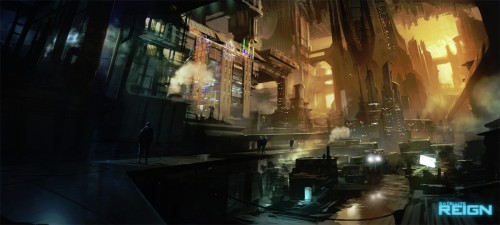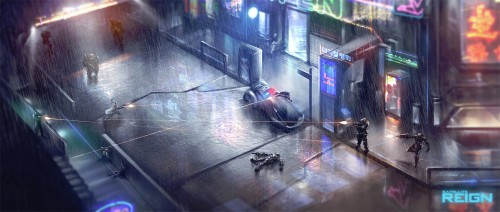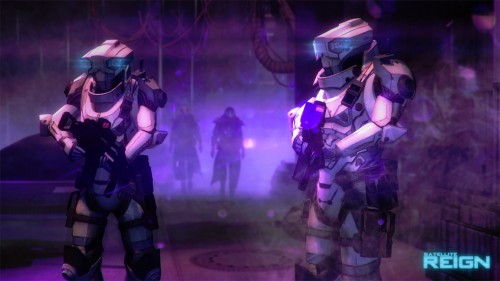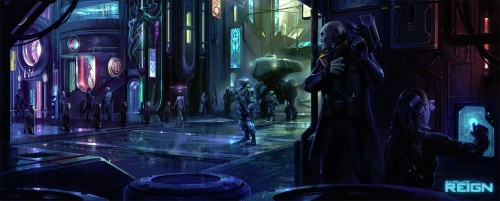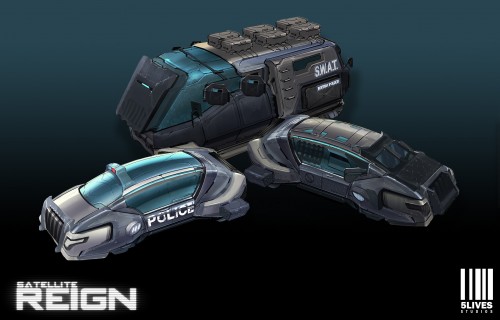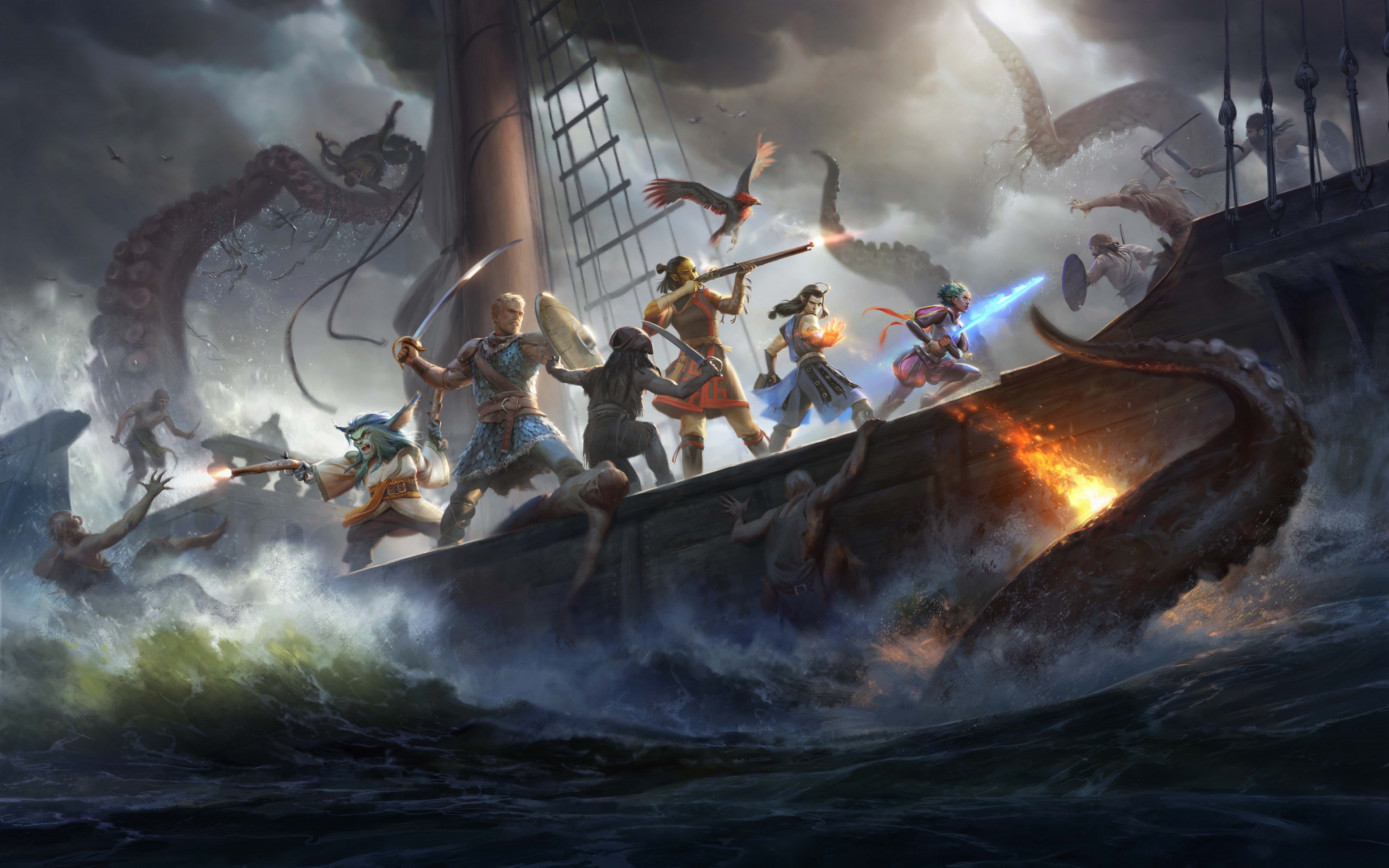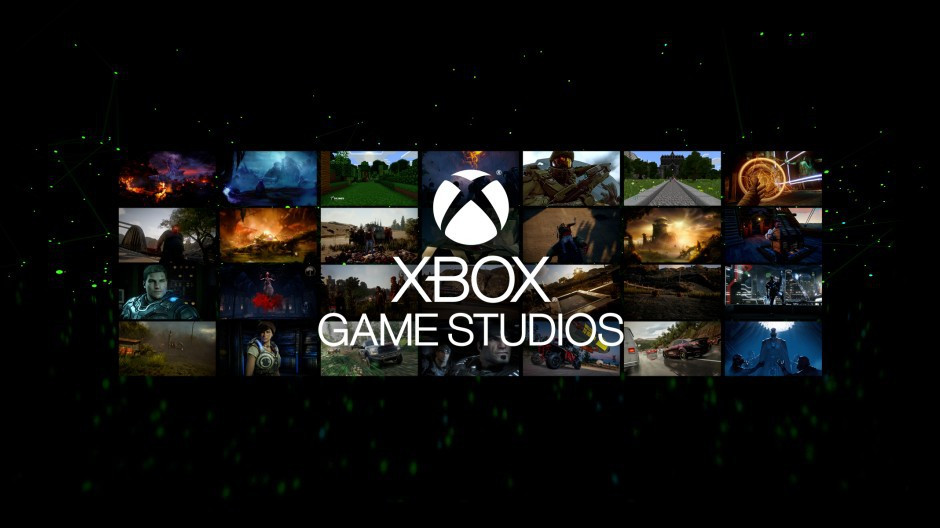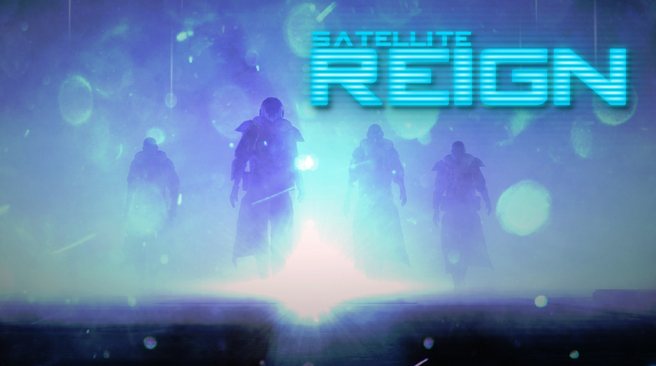
Like many internet savvy gamers I’ve found myself deeply ingrained in the Kickstarter phenomena. It’s impossible to say which investments will pay off, even if some already have (see: Double Fine’s Broken Age), but most of the upcoming titles look really exciting and seem to be shaping up well. I think it’s the allure of helping smaller studios get unusual and otherwise dead franchises out the door that keeps me coming back. Obsidian’s Pillars of Eternity is a great example. With the golden age of Western developed CRPGs long since past, how many high quality titles from the genre do we see this day and age? Few, if any. So to see a well established developer like Obsidian try to bring the genre back in a significant way is something I’m happy to support.
Another great example is one that hits a little closer to home, metaphorically and literally: Satellite Reign from 5 Lives Studios. You might remember the Kickstarter pitch (now successful), promising a return to isometric squad strategy made famous by the Syndicate franchise (a personal favourite), all contained within a sprawling cyberpunk open world. More than just being a big Syndicate fan, I felt attached to the project because, unlike so many other Kickstarters, this one was coming from within Australia. Satellite Reign is being developed by Brisbane based developer 5 Lives Studios, a collective of industry veterans keen to revive such an iconic franchise with a new coat of paint.
Being the excitable man I am, I took the opportunity to throw some questions at the team, specifically Brent Waller and Chris Conte, who were delighted (I hope) to provide me with some insight into the Kickstarter trials and tribulations, development background, and what backers can expected from a complete Satellite Reign. Enjoy!
Jarrod – Rocket Chainsaw: 5 Lives Studios was founded on Satellite Reign. Tell us a little bit about how the group came to be, your collective experience, and the process the team went through that lead to Kickstarter direction.
Brent Waller: The majority of us have been working together for about 6 years, roughly. Brent, Chris, Dean and Mitch were all on the same team at Krome Studios. After they closed up shop, we all slowly trickled into Sega Studios Australia, where Mike was already working. Mike was previously at Krome as well, though on a different team, so we didn’t really work together before meeting up with him at Sega.
Around late March 2013, Sega announced they were closing down the studio upon the completion of Castle of Illusion for Disney in August of that year. That actually gave us all a lot of breathing room, as well as time to sit down and plan our future, rather than frantically applying for jobs elsewhere. Mike actually initiated it all when he emailed practically everyone in the studio, asking if anyone was interested in Kickstarting a spiritual successor to Syndicate. People mostly assumed he was joking, since Mike has a reputation of sending silly/sarcastic emails to entire teams, but being huge fans of the series ourselves, the four of us pounced on the idea immediately. Given our past history working together, we jumped straight in and started planning that weekend.
What followed was about 4 months of frantic planning and working on the pitch during our evenings, while we wrapped up production on Castle of Illusion during the day.
Jarrod-RC: Thanks to Kickstarter we’re seeing the return of classic point-and-click adventures, isometric CRPGs, and more. Satellite Reign aims to be a successor to Syndicate. Had the team considered working on a spiritual successor to any other franchise or genre for your debut game? Why Syndicate?
Brent: It was Mike’s history with Syndicate, and the rest of the teams affinity with those games that originally pushed us in that direction. As soon as we started researching a bit more, we realised there was really no other option remotely as promising as the one we were looking at. With EA’s reboot as an FPS having just fallen foul of fans, and the fact that there really hasn’t been anything like the the original games in 16 years, we knew there was a gap there which wasn’t being filled by any other developers.
Jarrod-RC: The Australian games industry has seen many ups and downs over the last few years, amongst them the success of Halfbrick and Firemonkeys, and on the other end the closure of Blue Tongue. Do you see the independent boom of modern times, including Kickstarter, as beneficial to Australian development? How do you see the local industry evolving over the next few years?
Brent: Having all lived through the death of Krome and Sega (Mike was also at Pandemic and THQ when they closed), we’ve all been witness to the collapse of the Australian industry as a for-hire, outsourcing resource for big publishers. With the increase in the Australian dollar against the US, and the government subsidies provided to developers in countries like Canada, there really wasn’t much hope for publisher-funded titles in the Aussie games industry. After the success of titles like Minecraft, the doors have really opened up for indie developers to interface directly with their customers, combined with crowd sourcing and Steam’s initiatives like Greenlight and Early-Access, there really hasn’t been a better time to go indie.
In the future we can see a lot more home-grown, garage games popping up and supporting smaller pools of talent across more studios than lots of talent at 4-5 large studios.
Jarrod-RC: Has the process of funding a project through Kickstarter been what you expected? What have you experienced and learned, that could be passed on to other Kickstarter hopefuls?
Brent: We didn’t really know what to expect, we busted arse getting the pitch polished, and were under the assumption we could take a break and relax a bit after months of prep work. We actually had so much more work during the campaign than we anticipated, like answering questions, doing interviews, and generating new content for updates and filming videos. We also had well-laid plans for the frequency of our updates, and what information they would contain, but that was quickly thrown out the window.
We ended up being more reactive through the campaign as we responded to the demands of the backers who wanted information on particular aspects of the game. There was some stuff we didn’t end up showing because we knew the backers wouldn’t be interested, or they were more interested in seeing something else.
We’d recommend to anyone planning a crowd sourcing campaign to take note of industry events, holidays or other dates that might potentially affect your audience by drawing their attention away from their computer, particularly your start and end dates. We ran our campaign over 4th of July and that was one of the lowest days funded overall.
Also don’t underestimate rewards, there were a few rewards like a boxed copy of the game that we didn’t offer initially as we assumed it would be too expensive. After some research though, we discovered it was relatively affordable, and we could offer it to our backers part-way through the campaign.
We could go on forever about the things we learnt during the campaign, it was a great experience but we hope to not to ever need to do it again.
Jarrod-RC: Given no limitations and barriers, what does the team envision for 5 Lives Studios beyond Satellite Reign? What would the team like to accomplish, and what games do you hope to make?
Brent: Beyond the first game we hope to be successful enough to develop and self-finance a sequel and/or expansion without having to go back to Kickstarter, that’s our goal with Satellite Reign. Beyond that, we hope to explore other genres, new IPs. We all have a love of games of all types, so we’d love to experiment in other genres. We’d all love to put out an original indie game in the vein of something like Journey. We have a ton of potential ideas, it’ll be about narrowing them down over the course of the next couple years. We’re also not adverse to the idea of exploring the universe we’re building in other media or types of games, though we’re in no rush to go turning Satellite Reign into a FPS.
Jarrod-RC: Satellite Reign promises an open cyberpunk city simulator, NPCs and corporations responding to emergent gameplay. How deep does the simulation go, and what variety can we expect from NPCs and their day/night cycles? Has the team come across any surprising, unexpected responses to tested behaviour in this simulated environment?
Chris Conte: We are still early in development of the simulation, but we are already seeing the early stages of life in the city. Civilians wander around and flee from gunfire, enemies will try to arrest you if you are walk into a restricted facility, and if you respond by pulling out your guns, they all run for cover and start calling for reinforcements. We want players to really feel like they are wandering through a city that is alive, even without the players intervention. Corporate soldiers arresting civilians, drunks wandering out of bars and start fights, muggers hiding in the alleys, venders selling noodles to hungry passers by.
Jarrod-RC: It wouldn’t be cyberpunk without augmentations. What augmentation upgrades and skills will be split between the four classes? Can players expect a mix of combat and social augmentations? Do certain augmentations allow for non-combat experimentation within the city simulator?
Chris: At the moment, we have divided the augmentations into head, arms, legs and chest varieties. Your agents will be able to equip any augmentation regardless of class, but some augmentations may give bonuses to specific classes. For example, one of the head augmentations could boast that it has superior eye implants which may give all of the agents an accuracy bonus, and a small increase to their firing range, but also give your assassin an extra damage bonus for his “Power Shot” ability. Alternately you could go for a head augmentation that increases the Hacker’s “hacking” skill, or the soldiers “intimidate” ability. We want to give the player as many choices as possible to allow them to customise their team the way they want to, regardless of play style.
Jarrod-RC: The combination of four classes should allow for some crazy combat strategy. What tools, weapons, and combat augs will be available to players, and what tactics can they apply by combining them? What types of hostile NPCs will players encounter?
Chris: Plasma beam weapons, rocket launchers, high powered laser sniper rifles, explosives, smoke grenades, scanners, jammers… We are wedging as many cool weapons, tech and augmentations in the game as we can manage. The idea behind each item or weapon is that they have a specific purpose, and it will be up to the players to mix and match all the different options to find the tactics that work best for your play style.
As for hostiles… the main enemies you will face are the “Hammerheads”. He is the main soldier used by the corporations to fight of rival corporations and perform “hostile takeovers”. They are the meat of the corporate armies, and will be equipped with a variety of weapons, armour, shields and gear all designed to put an end to your agents!
Jarrod-RC: Though the stretch goal is yet to be met, what ideas does the team have for co-op multiplayer missions?
Brent: Our idea for co-op is less about specific missions built for co-op and more being able to play through the entire campaign with 4 human players. We’ve designed the game to have each of the 4 classes to have a symbiotic relationship, where they have to work together to succeed. We feel that design principle will carry across to co-op almost seamlessly and add a lot of depth to the game.
Jarrod-RC: Though critically acclaimed and not without an enduring legacy, the last major Syndicate game (Syndicate Wars) launched almost a decade ago. Satellite Reign acts as a spiritual successor, but what has the team learned since that will go towards improving the Syndicate formula?
Brent: A lot has happened in the gaming world since Syndicate Wars. Some of the basic actions players now expect from a modern RTS just didn’t exist back then. We’re bringing the genre into the modern age by taking all that’s been learn in the past 18 years. One of the major things we wanted to address was the habit of just grouping all four agents into a group and just marching them around the level as if they were one unit. Through our design, we are encouraging the players to exploit the individual strengths of the four agents types, keeping the combat and infiltration engaging.
Jarrod-RC: How will Satellite Reign‘s narrative be told? Is this a game where story is presented through cutscenes, or drip fed through discoverable dialogue and secrets? Which games, literature, or films have gone towards inspiring the story and setting?
Brent: It’s partially due to budget but mostly due to our own preferences, but we’ve always liked games where you as the player experience the story in-game as opposed to cutscenes. Much like Deus Ex, we want the players to uncover the story as they play through in-game communications and dialogue. We feel it’s much more memorable and enjoyable in an interactive medium to uncover and unravel a story, rather than just sit there and passively be told one.
Jarrod-RC: Unity engine seems to be a popular choice these days for a lot of independent and Kickstarted projected. How easy is the modern iteration of Unity to work with compared to other licensable middleware? The team recently showed off impressive screen space reflections. What other rendering effects can we expect, fitting for a cyberpunk setting?
Brent: Unity is a breeze to work with, and it makes getting our art assets assets into the game incredibly easily, which allows us to iterate and tweak quickly.
Jarrod-RC: We see you guys have an Oculus Rift devkit in the office. Impressions? Thoughts on VR technology in gaming?
Brent: We’ve been impressed so far, but after playing through some demos there’s a lot of thought and testing that needs to be put into how it’s implemented. We’ve seen some great examples of how to and how not to implement it in a game. Mike has a very early implementation of it in Satellite Reign he’s been on working on in his own time. It’s actually surprisingly effective from a top down perspective. Some of the issues we’ve found in existing demos (like the disorienting or detached-feeling from your body in some FPS demos), aren’t as prominent, perhaps due to our distanced camera. It feels more like you’re a sort of observer (which actually ties into our story and how the player is involved). For a game like ours, it makes it very easy to quickly survey the battlefield with a quick turn of your head, something you can’t really do with a keyboard and mouse.
It’s still in very early stages though, and more of a wish-list feature, so it’s not guaranteed to be included. Not in the initial release, at least.
Huge thank you to Brent Waller and Chris Conte for taking the time to sit down and not only read my rambling, but respond with such depth and enthusiasm. Hopefully this interview has helped you, faithful reader, learn a little more about this very exciting project, one I personally cannot wait to play. If the future is bright, and I believe it is, Satellite Reign will not only be the successor to the Syndicate franchise I’ve long been waiting for, but also lead healthy industry growth within the Australian developer community.
If you’d like know more about 5 Lives Studios and the Satellite Reign project, or contribute to their funds, you can visit there official website here: http://satellitereign.com/



